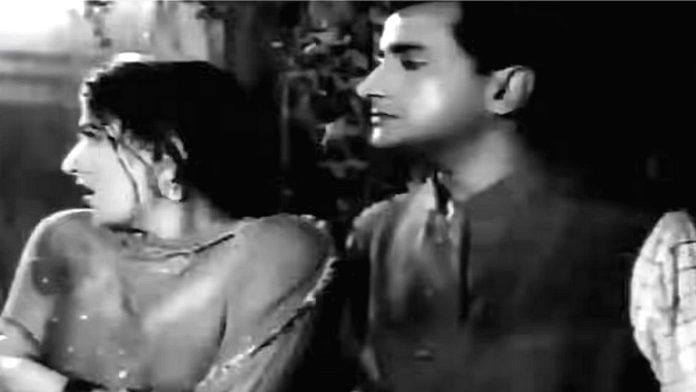On the surface, PL Santoshi’s 1960 film Barsaat Ki Raat looks like just another love story shadowed by social disapproval. What sets it apart, however, is how Urdu poetry and qawwalis are not just decorative flourishes but woven into the very fabric of its storytelling.
While the same year also gave audiences the grandeur of Mughal e-Azam, with its lavish Urdu dialogues and songs, Barsaat Ki Raat carved its own space. If Mughal-e-Azam was 1960’s top earner, Barsaat Ki Raat, starring Bharat Bhushan and Madhubala, stood second.
Bhushan plays Aman Hyderabadi, a struggling Urdu poet, while Madhubala is Shabnam, the daughter of a wealthy man who is intent on her marrying someone of equal social standing. Their love blossoms under the cover of monsoons, ghazals, and poetry, but as with any classic romance, societal barriers emerge to pull them apart.
Though audiences lapped up the stars’ chemistry, Barsaat Ki Raat’s staying power lies less in its storyline than in its music, written by Sahir Ludhianvi and composed by Roshan.
On Netflix’s The Roshans, Shah Rukh Khan confessed that his all-time favourite Roshan composition is the qawwali Na To Caravan Ki Talaash Hai, a 15-minute duel of verses.
“There has never been a qawwali like this, before or after,” added Sonu Nigam, who was also a guest on the Netflix documentary.
Sung by legends Manna Dey, Asha Bhosle, Sudha Malhotra, SD Batish, and Mohammad Rafi, the piece took nearly two weeks to record and film, and still stands as one of Hindi cinema’s most ambitious and enduring qawwalis.
“The genius of Roshan lay in using the ingredients (the voices and the poetry),” Nigam added.
In archival footage revisited for the documentary, playback singer Ira Nagrath, Roshan’s wife, recalled asking him why he would compose a 15-minute track when audiences barely had the patience for three-minute songs.
To which, Roshan replied, “One day, you will search for me with a lamp, and still not find me.” And, it stands true.
Also Read: A pocket watch, a broken toy, and a lifetime of regret —Anmol Ghadi was blockbuster
Heartbeat of the film
No mention of Barsaat Ki Raat can exist without talking about Madhubala’s luminous presence. This was the era when she reigned as Hindi cinema’s undisputed queen.
In 1960 alone, Madhubala gave one of her career’s most iconic performances as Anarkali in the historical epic Mughal-e-Azam. She also appeared in the crime thriller Jaali Note. Yet as Shabnam, she manages to bring freshness to the screen
Dilip Gupta’s cinematography captures the film’s mood with precision. The interplay of shadows, rain, and especially the close-ups of Madhubala’s expressive face create a visual poetry that mirrors the lyrical one.
Her eyes in the rain sequences convey more than words could. In a film steeped in heavy poetry and dense emotional exchanges, Madhubala’s performance balances subtlety with theatricality.
By contrast, the film did little for Bhushan, despite being among the successes in his 30-film career. He was typecast as the “poetic hero”, and his portrayal of Aman Hyderabadi felt like yet another addition to that repertoire.
Nevertheless, while his acting lacked the flamboyance of contemporaries like Raj Kapoor or Dilip Kumar, his sincerity made Aman believable. His chemistry with Madhubala is gentle rather than fiery, but that gentleness aligns perfectly with the rain-soaked romance the film portrays.
A musical soul
If Madhubala is the heart, Ludhianvi’s poetry is the soul of Barsaat Ki Raat.
Not many know that he originally penned the lyrics as standalone poems. It was only later that PL Santoshi and Roshan persuaded him to adapt them into songs for the film. It’s his words that have ensured Barsaat Ki Raat remains immortal.
Zindagi Bhar Nahi Bhoolegi Woh Barsaat Ki Raat, sung by Mohammad Rafi, remains a benchmark for romantic ballads. There is something almost revolutionary about Ludhianvi’s lyrics. Romance becomes a universal, visual statement of longing and fulfilment, with lines such as Haaye wo reshmi zulfon se barasta paani, Phool se gaalon pe rukne ko tarastaa paani (Ah, the water dripping from silken hair, longing to pause on flower-like cheeks).
When paired with Roshan’s compositions, the effect is transcendent. Often overshadowed by stalwarts like Naushad and Shankar-Jaikishan, Roshan came into his own with Barsaat Ki Raat.
Also Read: Dil Hi Toh Hai was a ‘Muslim social’ — but it put insaniyat and sharafat above khandan
Rain in Barsaat Ki Raat is not just atmospheric but symbolic. It represents longing, secrecy, and intimacy.
The meetings of Aman and Shabnam often happen under its veil, with the sheets of water acting as a silent witness to their passion. In many ways, the rain blurs boundaries, shielding them from scrutiny while heightening their emotions.
Sixty-five years later, Barsaat Ki Raat remains a must-watch for lovers of Urdu poetry and classical melodies. It redefined the role of music in cinema, brought qawwalis into the mainstream, and showcased Madhubala at her romantic best.
Above all, the film’s success cemented Roshan and Sahir Ludhianvi as one of the finest composer-lyricist duos in Hindi cinema.
(Edited by Asavari Singh)






